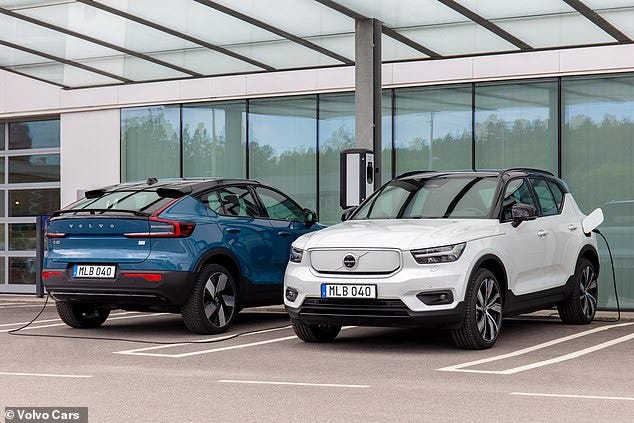Redux: Volvo's Real World Study Reveals Negligible Greenhouse Gas Reductions for BEVs
Volvo's Real Cars Lifecycle Analysis vs. Corrupted Argonne GREET Models
Preamble- CO2 Payback is a Bitch
Research funding from government and industry is how projects and careers are made. However, the massive flood of money for EVs and batteries by the Biden Administration has co-opted our scientific institutions as researchers clamor to feed at the Green Money Trough.
Here I will briefly compare the Argonne National Labs Synthetic Lifecycle Analysis called GREET to Volvo’s Real World Lifecycle Analysis using Volvo cars actually in production.
Two questions to keep in mind:
1) What is the “carbon footprint” of a BEV vs an ICE car from cradle to grave?
2) How far does one have to drive a BEV to “break-even”, so that greenhouse gas emissions for a BEV are equivalant to an ICE car and then lessen afterwards?
Follow the Money: Argonne National Labs GREET Modeling
Argonne's computer analysis called GREET uses assumptions and data to show that BEVs greenhouse gas (GHG) emissions will break even with ICE cars at relatively low mileages (as low as 15,000 miles). This is despite the enormous environmental costs and fossil fuel consumption to produce EV batteries.
GREET$ is led by :
Publish or Perish: GREET avalanche of papers and publications using your tax dollars - I bet you can’t wait to read every word!
Cure for Insomnia
More Argonne Pablum - Your Tax Dollars
The Real Car Volvo Lifecycle Study: BEV vs. Hybrid vs ICE Cars Manufactured Using the Same Platform
Volvo LifeCycle Analysis Matrix and Distilled Findings
The “real world” EV study published by Volvo is mostly apples to apples, in that Volvo compares different modes of locomotion (BEV, hybrid, gas) within a single Volvo car platform, everything else equal.
The car platform shares a common assembly line and suppliers (except for the electric motors and supporting systems). Each phase of the Life Cycle is analyzed, and Volvo compares GHGs emissions from each mode of locomotion with fueling or charging, as well as the GHGs emitted when a car is driven (use phase).
In the study, to charge the cars, Volvo compares bestcase or 100 % renewable wind power to more realistic real world global and EU 28 mixes of energy that comprise of a mix of fossil, nuclear, hydro and some wind and solar
Volvo compared the same platform or car (body, chassis, design, etc) with different power modes, and concluded that GHG emissions from making EVs are 70% higher than petrol models due to battery manufacturing, and suggests that it can take up to 9 YEARS of driving before they become “greener”, depending on how much you drive. This is due to large amount of fossil fuels that are combusted to create batteries, notwithstanding water use, mining operations, remediation, and general environmental destruction.
To quote:
“When also including the Li-ion battery modules and Volvo Cars manufacturing, the GHG emissions are nearly 70 per cent higher for the C40 Recharge compared with XC40 ICE.”
Volvo also showed that the bestcase breakeven point for greenhouse gases while using the car (use phase) is at least double that of the optimistic Argonne GREET computer model:
GREET Synthetic Model: 15,000 miles
Volvo Real World Best Case: 30,450 miles
To quote:
“For all three electricity mixes in the LCA, the breakeven occurs at 49,000, 77,000 and 110,000km respectively, all within the assumed life cycle of the vehicle (200,000km).”
The 2 key points are:
A BEV must be charged from a completely “renewable” energy source such as wind, hydro, and/or solar to reach the Volvo best case GHG breakeven of 30,000 miles vs the 15,000 miles per Argonne GREET computer model.
For BEV breakeven using the more realistic global and EU 28 mix of electricity from coal, gas, nuclear, etc with a sprinkling of “renewables” you will need to drive 68,350 and 47,845 miles respectively !
Quote me: “BEVs are a total and complete waste and will not make one iota of GHG difference, except in an inner city where you don’t want smog”
Why? Because automobiles and light trucks only contribute a small fraction of GHGs to the global total per EPA and IPCC studies.
Therefore, replacing all of the world’s cars with EVs to lower GHGs is a worthless exercise - the slice of the GHG pie is miniscule compared to the other emitters, while the environmental and social costs of EV battery production are almost incalculable.
The Numbers:
Per above, 11.9% of GHG gases (CO2 mostly) arise from road transport. This includes emissions from burning of petrol and diesel from all forms of road transport which includes cars, trucks, lorries, motorcycles and buses.
Importantly, 60 % of road transport emissions come from passenger travel (cars, motorcycles and buses); and the remaining 40 % is from road freight (lorries and trucks).
Arithmetic
0.60 * 12 = 7.2 % GHGs from passenger travel (cars, motorcycles and buses)
Final Final Note
Norway has plenty of wind and hydro and other diversions - time to move there for the low GHG breakeven!
Other readings
Total USA EV Adoption Will Only Reduce Global Greenhouse Gas Emissions by 2.5 %
Replacing roughly 260 million USA internal combustion engine passenger and light trucks with EVs will only slightly reduce global greenhouse gases. This is because they only contribute about 2.5 % to the total of man-made global greenhouse gases. Further, the entire EV battery supply chain feeds off the destructive mining, extraction and refinement min…
China's Quest for World Domination via "Clean Energy" Manufacturing
China: where 75 % of “clean energy technologies” are manufactured When looking at where clean energy technologies and where the components are made, one thing is very clear: China dominates the industry, and the Western world is beholden to China, as trillions are poured into so-called “renewable clean energey technologies”. To create these products,



















Interesting!
I would be interested in comparing the two.
I will never buy an EV. Have seen much info similar to the great information you present here. More people need to get educated. Dirty green energy is part of the de growth Marxist agenda. Let the scales be even and the abundance of cheap fossil fuel, which continues to get cleaner with new technology, will continue to make the ICE king. The only way this changes is by the totalitarians banning ICE, and crony capitalism that subsidizes EVs. In an even match, the hands down winner is ICE. Absolutely no EV for me.